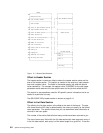of each entry field is , the entries have different lengths and the format tells the
length of each entry.
The list data sections for the QSYLOBJP API are shown in the “OBJP0100 Format”
on page 5-14 and the “OBJP0200 Format” on page 5-14. This API has two pos-
sible formats.
For more information about formats and how to extract a field from a format, see
“Format” on page 3-5 and “Extracting a Field from the Format” on page 3-5.
Other Fields of Generic Header
The field called structure’s release and level is part of the generic header. This
field tells the layout of the generic header. For an original program model (OPM)
layout, this value should be 0100. For an Integrated Language Environment (ILE)
model layout, the value should be 0300.
The information status field tells you whether the information in the user space is
complete and accurate, or partial. You need to check the value of this field before
you do anything with the information in the user space (see 1 on page 5-9). Pos-
sible values for this field follow:
C
Complete and accurate.
I
Incomplete. The information you received is not accurate or complete.
P
Partial but accurate. The information you received is accurate, but the API
had more information to return than the user space could hold.
If the value is P, the API has more information to return than what could fit in the
user space. If you received the value P, you need to process the current informa-
tion in the user space before you get the remaining information. The API returns a
continuation handle usually in the form of a parameter. You can use this continua-
tion handle value to have the remaining information placed in the user space. You
specify the continuation handle value that the API returned as the value of the con-
tinuation handle input parameter on your next call to the API.
The QSYLOBJP API provides a continuation handle in the header section (see 2
on page 5-14) to return the remaining information to the user space. The user then
passes this value back to the API as an input parameter (see 3 on page 5-14) so
that the API can locate the remaining information and place it in the user space.
If the API does not have a continuation handle and the information status field
value is P, you must further qualify what you want in the list. In other words, you
must be more specific on the parameter values that you pass to the API. For
example, the QUSLOBJ API asked to get a list of objects; however, all of the
objects on the system would not fit in the user space. To further qualify or limit the
number of objects returned, the user might specify all libraries that start with a spe-
cific letter.
For more information about continuation handles and how to use them, see “Con-
tinuation Handle” on page 2-25.
Chapter 5. List APIs 5-3


















